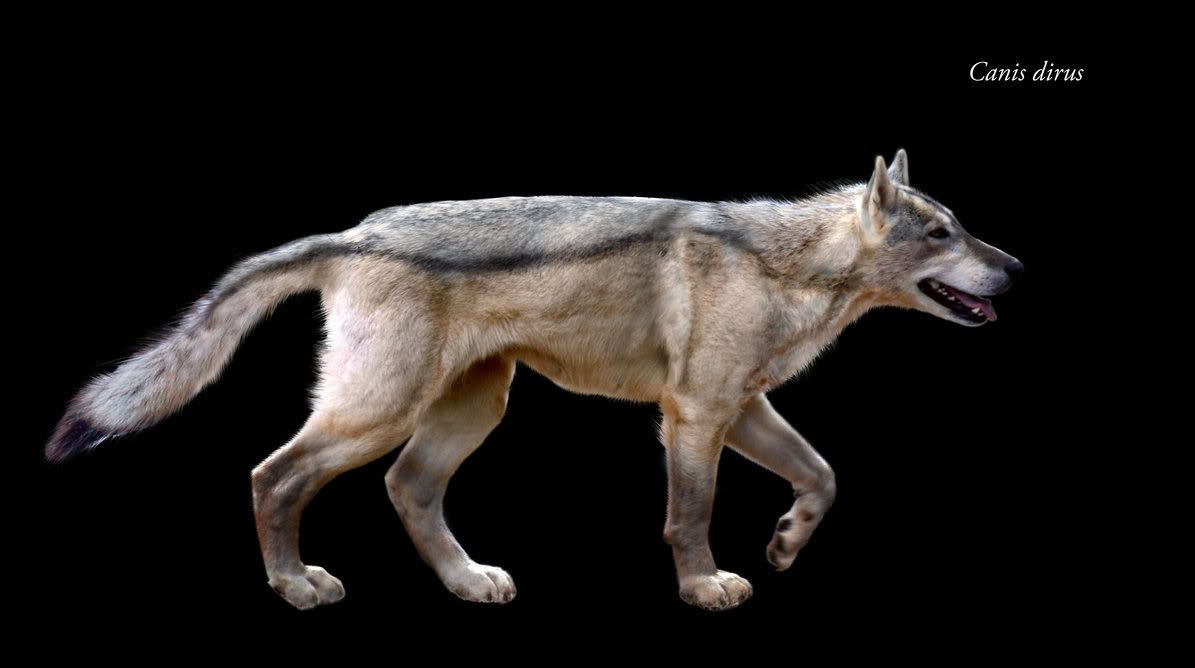Post by dinosauria101 on Apr 11, 2019 5:43:05 GMT 5
American Scimitar - Homotherium serum
The scimitar cat is the lesser known of the two ‘sabre-toothed’ cats of ice age North America. This extinct cat was a formidable hunter and evidence suggests it was the major predator of mammoths during its time. Scimitar cats were about the size of a modern lion but had longer, more slender limbs. Their most distinctive feature was their sabre-like teeth a feature that they shared with their American cousins, sabre-toothed cats. Several key features distinguish scimitar cats from sabre-tooths. The canine teeth of scimitar cats were shorter and more slender than those of the sabre-tooth and were finely serrated, making them powerful slicing tools. The scimitar cat had a somewhat unusual build with comparatively long front legs, a sloping back and shorter hind legs. Height: 1.1m (3.5ft) at the shoulder, Weight: 150-250 kg (330-550lb)

Dire Wolf (pack of 5) - Canis dirus
The Dire wolf (Canis dirus) is an extinct carnivorous mammal of the genus Canis, and was most common in North America and South America from the Irvingtonian stage to the Rancholabrean stage of the Pleistocene epoch living 1.80 Ma – 10,000 years ago, existing for approximately 1.79 million years. lthough it was closely related to the Gray Wolf and other sister species, Canis dirus was not the direct ancestor of any species known today. Unlike the Gray Wolf, which is of Eurasian origin, the Dire Wolf evolved on the North American continent, along with the Coyote. The Dire Wolf co-existed with the Gray Wolf in North America for about 100,000 years. The Dire Wolf was larger than the Gray Wolf, averaging about 1.5 metres (5 ft) in length and weighing between 50 kg (110 lb) and 79 kg (174 lb). Despite superficial similarities to the Gray Wolf, there were significant differences between the two species. The legs of the Dire Wolf were proportionally shorter and sturdier than those of the Gray Wolf, and its brain case was smaller than that of a similarly sized gray wolf. The Dire Wolf's teeth were similar to the Gray Wolf's, only slightly larger, pointing to a hypercarnivorous to mesocarnivorous activity. Paleontologist R.M. Nowak states the dietary characteristics are primarily carnivorous as well as partially omnivorous.

Credit to Wikipedia
The scimitar cat is the lesser known of the two ‘sabre-toothed’ cats of ice age North America. This extinct cat was a formidable hunter and evidence suggests it was the major predator of mammoths during its time. Scimitar cats were about the size of a modern lion but had longer, more slender limbs. Their most distinctive feature was their sabre-like teeth a feature that they shared with their American cousins, sabre-toothed cats. Several key features distinguish scimitar cats from sabre-tooths. The canine teeth of scimitar cats were shorter and more slender than those of the sabre-tooth and were finely serrated, making them powerful slicing tools. The scimitar cat had a somewhat unusual build with comparatively long front legs, a sloping back and shorter hind legs. Height: 1.1m (3.5ft) at the shoulder, Weight: 150-250 kg (330-550lb)

Dire Wolf (pack of 5) - Canis dirus
The Dire wolf (Canis dirus) is an extinct carnivorous mammal of the genus Canis, and was most common in North America and South America from the Irvingtonian stage to the Rancholabrean stage of the Pleistocene epoch living 1.80 Ma – 10,000 years ago, existing for approximately 1.79 million years. lthough it was closely related to the Gray Wolf and other sister species, Canis dirus was not the direct ancestor of any species known today. Unlike the Gray Wolf, which is of Eurasian origin, the Dire Wolf evolved on the North American continent, along with the Coyote. The Dire Wolf co-existed with the Gray Wolf in North America for about 100,000 years. The Dire Wolf was larger than the Gray Wolf, averaging about 1.5 metres (5 ft) in length and weighing between 50 kg (110 lb) and 79 kg (174 lb). Despite superficial similarities to the Gray Wolf, there were significant differences between the two species. The legs of the Dire Wolf were proportionally shorter and sturdier than those of the Gray Wolf, and its brain case was smaller than that of a similarly sized gray wolf. The Dire Wolf's teeth were similar to the Gray Wolf's, only slightly larger, pointing to a hypercarnivorous to mesocarnivorous activity. Paleontologist R.M. Nowak states the dietary characteristics are primarily carnivorous as well as partially omnivorous.

Credit to Wikipedia


